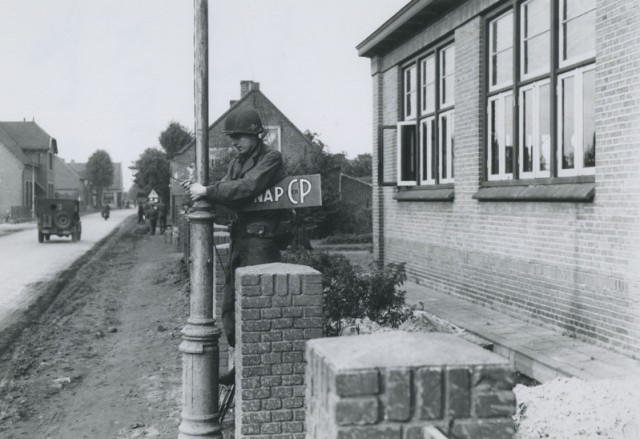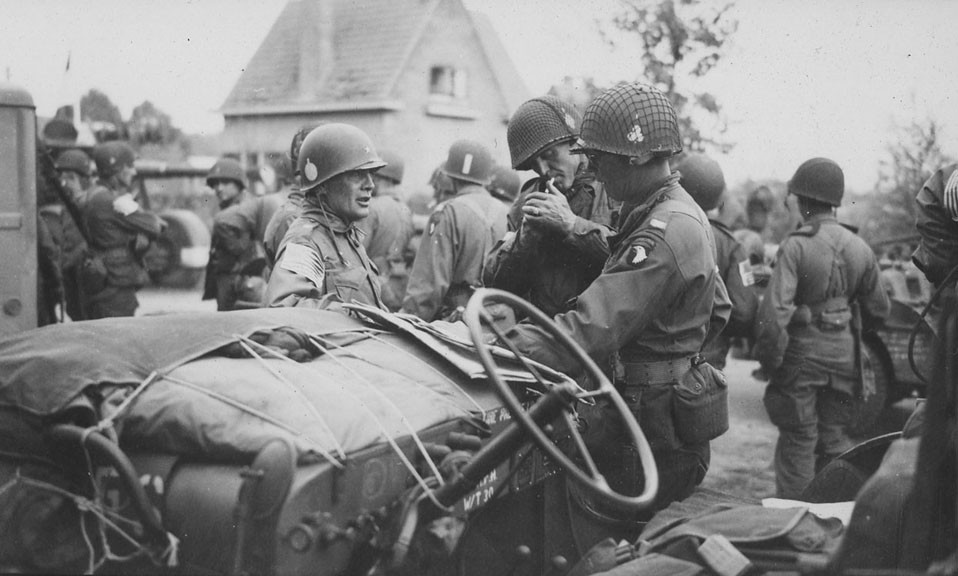At 0330, October 5, 1944, a patrol of five members of Easy Company, 506th Parachute Infantry Regiment (PIR), 101st Airborne Division was ordered to occupy an outpost near the south side of the dike near Randwijk, Holland. As Private Joe Lesniewski reached the summit of the dike, he noticed two things: a German machine-gun setup to his east, and a German infantryman preparing to throw a potato-masher grenade at his comrades. As Lesniewski called out a warning, the grenade was thrown and exploded, wounding four of the five paratroopers. Unbeknownst to them at the time, the Easy Company patrol had run into a full company of SS troops. As the diversionary assault by the SS was taking place, the 363rd Volksgrenadier Division was preparing to launch a massive attack against the 506th Regimental Headquarters at Opheusden at daybreak. The German objective: removal of all Allied troops from the "the Island," a five-kilometer area bordered by the Lower Rhine to the north and the Waal River to the south.
As the 101st occupied the Island, they realized the overall Allied operation, code-named MARKET-GARDEN, had failed. It was not the outcome the Allies envisioned when they entered Holland two weeks earlier on September 17. The extremely ambitious plan was to liberate Holland and gain entrance into Germany. Allied success hinged on the capabilities of the paratroopers to secure the highway and bridges from Eindhoven north to Arnhem. But, when the British encountered strong enemy resistance and were unable to capture the Arnhem Bridge, MARKET-GARDEN failed.
By the time the 101st occupied the Island, the fighting in Holland had turned into warfare more reminiscent of World War I. German artillery from across the Lower Rhine had large portions of the Island zeroed-in, which made daylight movement by Allied soldiers virtually impossible. Allied soldiers on perimeter defense were dug into shallow foxholes on the sides of the dikes. Often, German soldiers were dug into the opposite side. During the nighttime, the Germans repeatedly attempted to infiltrate the perimeter. It was such an attempt that the Easy Company patrol ran into on October 5.
The patrol fell back and eventually made its way to the company command post (CP). A fifteen-man patrol, organized by Captain Richard Winters, moved out to the location where the previous patrol had made contact with the Germans. Winters decided to recon the situation himself. He crawled to the top of the dike and observed a road which ran parallel to it. He ordered his men to follow him. When they were 200 meters from the road, they observed that the Germans had positioned a machine-gun and a rifle team on top of the dike. Winters assigned each of his men a target and positioned his machine-gunners and mortar team to direct their firepower towards the German machine-gun. Winters gave the order to fire. All seven German riflemen were hit.
After ordering reinforcements, Winters continued to assess the situation. He recognized that the rest of the enemy was well concealed, that his troops\' position could be easily flanked and that the Germans, if not stopped right then and there, would have unfettered access to the 2nd Battalion Command Post down the road. When reinforcements arrived from Easy and Fox Companies, Winters ordered his men to fix bayonets. In three columns, the Americans moved toward the road while their machine-guns laid down suppressing fire. Reaching the top of the road first, Winters shot a sentry and noticed a group of more than 100 Germans to his right. He emptied three clips into the masses before the rest of his men arrived. The Germans, now in utter confusion, were easy targets for Winters and the patrol. The Germans started retreating and were joined by a previously undetected SS company. With the Germans retreating towards the Lower Rhine, Winters radioed for British artillery support, which found its mark.
The Germans regrouped and formed a counterattack on the Americans' right rear flank and radioed for their own artillery support. Realizing the situation, Winters ordered his men to pull back. As Winters and his men returned to the dike, eighteen paratroopers were wounded by the German artillery.
All told, Winters and thirty-four men of Easy and Fox Companies had taken on two German SS companies of nearly 300 men. After the 363rd Volksgrenadiers attacked the 101st at dawn, it was realized that had Winters not ordered his men to fix bayonets and attack the two SS companies, they would have hit the regimental headquarters in full force. It would have been a disaster. In the heat of the action, Winters' decision to move his men forward had been the right one and it inevitably saved lives. Colonel Robert Sink, the 506th PIR commander, acknowledged it as well when he recognized 1st Platoon of Easy for gallantry in action.












Social Sharing